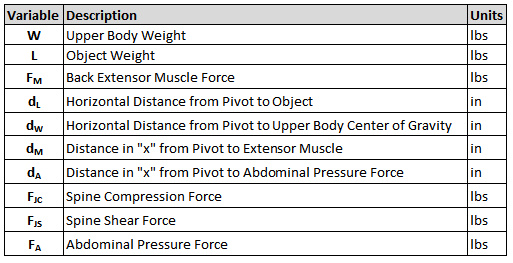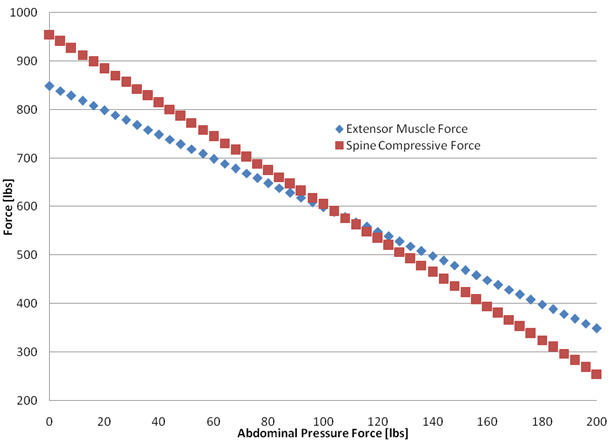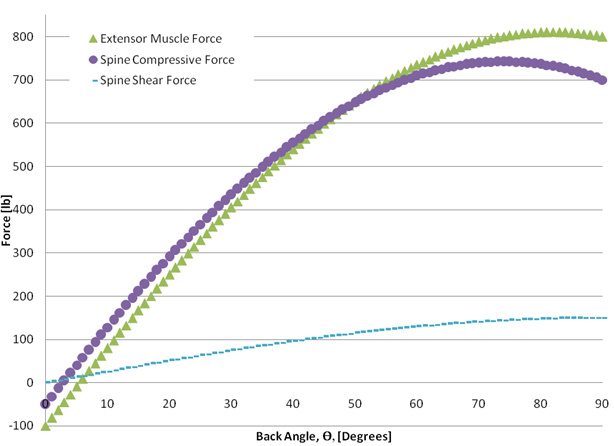Biomechanics of Lower Back Engagement in Lifting
April 18, 2011
This one is a little dry, so feel free to skip to the conclusions. It started as a report for the Orthopaedic Biomechanics class I’m taking. It’s nothing revolutionary in the field (not even close), but I thought you all might be interested in reading it nonetheless.
While the lifting of heavy objects is daily routine for a smaller share of us than our hunter-gatherer ancestors, it can be said with certainty that each of us will eventually lift something of substantial weight. We know that poor form can result in injury – everyone has been told to bend at the knees with a straight back – but what magnitudes of forces are sustained by our bodies in these movements? Is it beneficial to bend at the knees?
Today we’ll examine the forces exerted by the back extensor muscle (lower back) and supported by the spine during heavy lifting. The movement examined is a straight-leg back extension carrying a 50lb weight with relaxed arms.
Analysis
The body was first simplified into the system shown below.
Figure 1. System Geometry and Forces [Courtesy S.M.Klisch, Cal Poly, San Luis Obispo, CA]
This simplification required a few assumptions, most notably that the spine acts as a rigid body, that the muscles promoting extension at the hip can be expressed as a single linear force, and that the problem can be modeled with the rudimentary geometry presented.
Table 1 offers a quick-reference list of the variable designations.
Table 1. Variable Designations
The following values were set as known constants: W=100lb, L=50lb, dM=2â€, dA=5â€.
dW and dL were found with trigonometry:
Having found expressions for the moment arms, we are able to sum the moments around the pivot point, a sum set to equal zero because we are analyzing the system as static.
Rearranging to solve for FM:
Then summing forces in the selected x and y directions (see coordinate axis on Fig. 1):
And finally simplifying gives us the equations for the last two unknown forces, the shear and compression forces in the spine:
These eight equations were then used to solve for the desired parameters.
Results
Figure 2.Back Extensor Muscle Force and Spine Compressive Force During Lifting at Varying Abdominal Pressure Force (click to enlarge)
Figure 3.Back Extensor Muscle Force, Spine Compressive Force, and Spine Shear Force During Lifting (click to enlarge)
Discussion
Figure 2 shows that the possibly injurious forces incurred during this type of lifting can be greatly reduced with increased abdominal pressure force. This emphasizes the importance of tightening one’s abdominal muscles while lifting heavy things. Though this is common advice in the weight room for movements like the deadlift, this is certainly less frequently shared among laypeople than the recommendation to bend at the knees.
Figure 3 underscores the benefit of that more common advice. Bending at the knees allows the lifter to maintain a more upright back, thereby reducing the “Back Angle,†plotted on the horizontal axis of Figure 3. It is clearly the case that a smaller back angle results in smaller muscle and spinal forces. It appears the conventional wisdom is correct – a straighter back reduces the risk of injury to the lifter.
This examination of the effect of back angle does present with some peculiar behavior. It is immediately upsetting that the force is negative at near-zero back angles. This is a result of the fixed abdominal pressure force of 100 lbs for this dataset, and the applied location chosen for that force. In a human lifter, the abdominal pressure would not be increased to a point which would result in an imbalance. It also seems odd that the force reaches a maximum value and begins decreasing at near-perpendicular “back angle”. This is a result of the geometry chosen and depicted in Figure 1. The moments from the body weight and load are at a maximum when their respective moment arms are largest – the angle at which the pivot point and load application fall in line horizontally – an angle less than ninety degrees.
This examination has some limitations, and could be made to be more accurate or representative of reality. However, the conclusions arrived at would likely remain unchanged: lifters should be instructed to tighten their abdominal muscles and maintain an upright back to reduce the likelihood of injury.
Another tactic that could be applied to prevent injury is to simply strengthen the back extensor muscles by loading them intentionally. As if you needed another reason to deadlift.
Entry filed under: Ortho. Tags: .










What’s Being Said